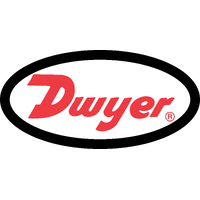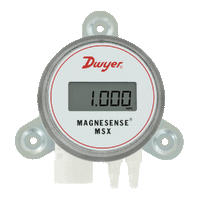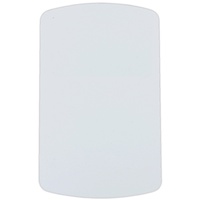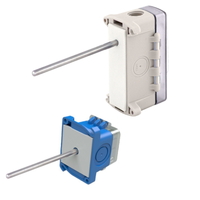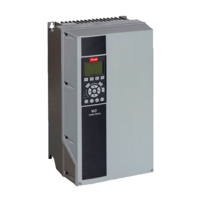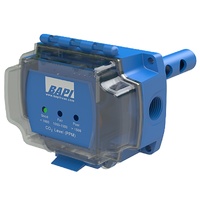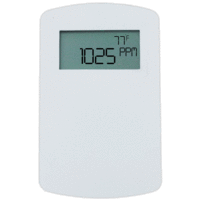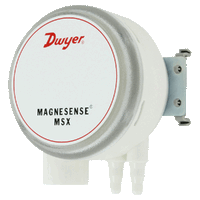
Description
If you’re an industrial electrician, automation technician, HVAC professional, or controls engineer, you know the cost of a missed pressure spike. One wrong reading can stall production, wreck a compressor, or create a dangerous fault.
That’s why the best choice we recommend at Controls Traders is a digital pressure gauge with an alarm and analogue outputs. It provides precise readings you can trust, alerts you before pressures hit unsafe limits, and streams live data directly into your control systems.
Here’s how they work, where they’re used, and what to look for when choosing the right model for your setup.
What is a Digital Pressure Gauge?
A digital pressure gauge measures and displays pressure using electronic sensors and a digital display instead of a mechanical dial.
Here’s the difference:
- Analogue pressure gauges rely on a Bourdon tube and needle to indicate pressure.
- Digital pressure gauges use strain-gauge sensors or piezoresistive technology to convert pressure into an electronic signal, displayed in clear, high-contrast digits.
Digital gauges offer higher accuracy, more straightforward calibration, and no parallax errors. Plus, you can get features like alarms, data logging, and analogue outputs that mechanical gauges can’t match.
Key Features of Digital Pressure Gauges with Alarm and Analogue Outputs
Before you choose a digital gauge, know what matters most. These aren’t just read-and-forget devices; the right features make all the difference in safety, accuracy, and system integration.
1. Alarms That Keep You Ahead of Problems
A built-in alarm is your first line of defence. These alarms trigger when pressure reaches pre-set thresholds, warning you before system damage occurs.
Example: In HVAC chillers, high-pressure alarms can prevent compressor burnout by stopping the system before it overheats.
2. Analogue Outputs for Integration
Analogue outputs (commonly 4–20 mA or 0–10 V) allow your gauge to feed real-time pressure data into PLCs, SCADA, or building management systems. This means your gauge isn’t an isolated readout; it’s part of your automation network.
3. Accuracy That Meets Industry Demands
High-quality digital pressure gauges typically offer ±0.25% to ±1% full-scale accuracy. That’s enough to meet tight tolerances in hydraulic systems, pharmaceutical processing, and clean gas monitoring.
4. Durability in Harsh Environments
Industrial-grade models often feature IP65 or higher protection, stainless steel housings, and shatter-resistant screens, essential for dusty plant rooms, outdoor installations, and corrosive atmospheres.
5. Easy Calibration
Digital gauges can be recalibrated via onboard menus or service tools without dismantling the unit. That’s less downtime and no risk of reassembly errors you get with analogue gauges.
Applications of Digital Pressure Gauges with Alarm and Analogue Outputs
Not every industry uses pressure the same way. These gauges fit into multiple environments, each with its own performance demands and safety requirements.
- HVAC systems: Monitor refrigerant or chilled water pressure, trigger alarms before system trips, feed live data to controllers.
- Process control: Maintain optimal pressure in bottling lines, chemical dosing, or pharmaceutical processes.
- Hydraulic systems: Protect pumps and cylinders from dangerous overpressure.
- Gas industry: Ensure safe handling of compressed air, natural gas, or speciality gases.
- Water treatment: Monitor pump discharge and filtration pressures with digital accuracy.
Benefits of Using Digital Pressure Gauges with Alarm and Analogue Outputs
A good gauge doesn’t just display numbers but changes outcomes.
From preventing costly breakdowns to improving operator safety, here’s why these gauges are worth the investment.
- Real-time protection: Alarms act before damage occurs.
- Lower maintenance costs: Early alerts prevent major breakdowns.
- Seamless integration: Analogue outputs link directly to automation systems.
- Improved safety: Staff are instantly alerted to unsafe pressures.
- Better compliance: Accurate readings help meet Australian standards for industrial pressure equipment.
For high-performance options, the Dwyer Omega DPG1000 range delivers rugged build, ±0.25% accuracy, and alarm/analogue output configurations ideal for HVAC and process control.
Frequently Asked Questions
What is the difference between a digital pressure gauge and an analogue pressure gauge?
Analogue pressure gauges use mechanical movement, while digital gauges use sensors and electronics. Digital models offer higher accuracy, clearer readings, and features like alarms and data outputs.
How do alarms work on a digital pressure gauge?
You set high and low pressure limits. When the gauge detects readings beyond these points, it activates visual, audible, or relay alarms to warn operators or trigger system responses.
Can a digital pressure gauge with an analogue output be used with other systems?
Yes. Most models offer standard 4–20 mA or 0–10 V outputs, making them compatible with PLCs, SCADA systems, and building management controls.
Do digital pressure gauges need regular calibration?
Yes, but calibration intervals vary by application. For critical systems like gas distribution or pharmaceutical manufacturing, six-monthly checks are common. Many models allow quick in-field calibration.
Where to Buy Digital Pressure Gauges
In Australia, a reliable supplier isn’t just about price but about stock availability, support, and product range.
Control Traders offers:
- Global shipping for remote projects.
- Post-sales support to help with setup and calibration.
- Sales and delivery with minimal lead times thanks to stocked shelves.
Looking for a digital pressure gauge you can trust? We're backed by 40+ years of combined industry expertise. We keep stock on hand so you’re not waiting weeks for replacements.
Browse the range now:
- Shop by brand
- Shop by product
- Or contact us / call 1300 740 140 for expert advice.
Reviews
Be The First To Review This Product!
Help other Controls Traders Pty Ltd users shop smarter by writing reviews for products you have purchased.
Digital Pressure Gauges with Alarm and Analogue Outputs
60197Description
If you’re an industrial electrician, automation technician, HVAC professional, or controls engineer, you know the cost of a missed pressure spike. One wrong reading can stall production, wreck a compressor, or create a dangerous fault.
That’s why the best choice we recommend at Controls Traders is a digital pressure gauge with an alarm and analogue outputs. It provides precise readings you can trust, alerts you before pressures hit unsafe limits, and streams live data directly into your control systems.
Here’s how they work, where they’re used, and what to look for when choosing the right model for your setup.
What is a Digital Pressure Gauge?
A digital pressure gauge measures and displays pressure using electronic sensors and a digital display instead of a mechanical dial.
Here’s the difference:
- Analogue pressure gauges rely on a Bourdon tube and needle to indicate pressure.
- Digital pressure gauges use strain-gauge sensors or piezoresistive technology to convert pressure into an electronic signal, displayed in clear, high-contrast digits.
Digital gauges offer higher accuracy, more straightforward calibration, and no parallax errors. Plus, you can get features like alarms, data logging, and analogue outputs that mechanical gauges can’t match.
Key Features of Digital Pressure Gauges with Alarm and Analogue Outputs
Before you choose a digital gauge, know what matters most. These aren’t just read-and-forget devices; the right features make all the difference in safety, accuracy, and system integration.
1. Alarms That Keep You Ahead of Problems
A built-in alarm is your first line of defence. These alarms trigger when pressure reaches pre-set thresholds, warning you before system damage occurs.
Example: In HVAC chillers, high-pressure alarms can prevent compressor burnout by stopping the system before it overheats.
2. Analogue Outputs for Integration
Analogue outputs (commonly 4–20 mA or 0–10 V) allow your gauge to feed real-time pressure data into PLCs, SCADA, or building management systems. This means your gauge isn’t an isolated readout; it’s part of your automation network.
3. Accuracy That Meets Industry Demands
High-quality digital pressure gauges typically offer ±0.25% to ±1% full-scale accuracy. That’s enough to meet tight tolerances in hydraulic systems, pharmaceutical processing, and clean gas monitoring.
4. Durability in Harsh Environments
Industrial-grade models often feature IP65 or higher protection, stainless steel housings, and shatter-resistant screens, essential for dusty plant rooms, outdoor installations, and corrosive atmospheres.
5. Easy Calibration
Digital gauges can be recalibrated via onboard menus or service tools without dismantling the unit. That’s less downtime and no risk of reassembly errors you get with analogue gauges.
Applications of Digital Pressure Gauges with Alarm and Analogue Outputs
Not every industry uses pressure the same way. These gauges fit into multiple environments, each with its own performance demands and safety requirements.
- HVAC systems: Monitor refrigerant or chilled water pressure, trigger alarms before system trips, feed live data to controllers.
- Process control: Maintain optimal pressure in bottling lines, chemical dosing, or pharmaceutical processes.
- Hydraulic systems: Protect pumps and cylinders from dangerous overpressure.
- Gas industry: Ensure safe handling of compressed air, natural gas, or speciality gases.
- Water treatment: Monitor pump discharge and filtration pressures with digital accuracy.
Benefits of Using Digital Pressure Gauges with Alarm and Analogue Outputs
A good gauge doesn’t just display numbers but changes outcomes.
From preventing costly breakdowns to improving operator safety, here’s why these gauges are worth the investment.
- Real-time protection: Alarms act before damage occurs.
- Lower maintenance costs: Early alerts prevent major breakdowns.
- Seamless integration: Analogue outputs link directly to automation systems.
- Improved safety: Staff are instantly alerted to unsafe pressures.
- Better compliance: Accurate readings help meet Australian standards for industrial pressure equipment.
For high-performance options, the Dwyer Omega DPG1000 range delivers rugged build, ±0.25% accuracy, and alarm/analogue output configurations ideal for HVAC and process control.
Frequently Asked Questions
What is the difference between a digital pressure gauge and an analogue pressure gauge?
Analogue pressure gauges use mechanical movement, while digital gauges use sensors and electronics. Digital models offer higher accuracy, clearer readings, and features like alarms and data outputs.
How do alarms work on a digital pressure gauge?
You set high and low pressure limits. When the gauge detects readings beyond these points, it activates visual, audible, or relay alarms to warn operators or trigger system responses.
Can a digital pressure gauge with an analogue output be used with other systems?
Yes. Most models offer standard 4–20 mA or 0–10 V outputs, making them compatible with PLCs, SCADA systems, and building management controls.
Do digital pressure gauges need regular calibration?
Yes, but calibration intervals vary by application. For critical systems like gas distribution or pharmaceutical manufacturing, six-monthly checks are common. Many models allow quick in-field calibration.
Where to Buy Digital Pressure Gauges
In Australia, a reliable supplier isn’t just about price but about stock availability, support, and product range.
Control Traders offers:
- Global shipping for remote projects.
- Post-sales support to help with setup and calibration.
- Sales and delivery with minimal lead times thanks to stocked shelves.
Looking for a digital pressure gauge you can trust? We're backed by 40+ years of combined industry expertise. We keep stock on hand so you’re not waiting weeks for replacements.
Browse the range now:
- Shop by brand
- Shop by product
- Or contact us / call 1300 740 140 for expert advice.
Reviews
Be The First To Review This Product!
Help other Controls Traders Pty Ltd users shop smarter by writing reviews for products you have purchased.








